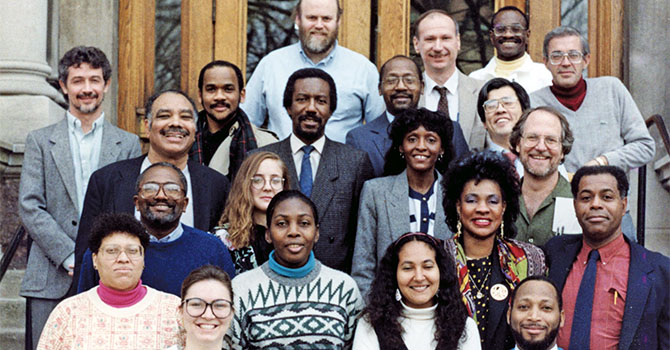Grass Roots: The Sustainable Shifts that Lead to Environmental Justice

Todd Ziegler, MS ’15
When civil rights leaders, environmentalists, and researchers converged on the university in 1990 for the Conference on Race and the Incidence of Environmental Hazards, they were part of a much larger, grassroots movement that brought environmental justice concerns to the national consciousness.
The conference was organized by School for Environment and Sustainability (SEAS) professors and environmental justice pioneers Bunyan Bryant and Paul Mohai. Conference presenters went on to form a group of scholars and activists focused on researching the disproportionate impacts of environmental hazards in communities of color and pressing policy-makers to take action. Known as the “Michigan Coalition,” this group played a key role in bringing environmental justice to the attention of the federal government and in the 1992 formation of the EPA’s Office of Environmental Equity—later renamed the Office of Environmental Justice—and helped set plans in motion for the First National People of Color Environmental Leadership Summit, held October 1991 in Washington, DC, where the 17 Principles of Environmental Justice were adopted.1
“Delegates to this conference wanted to send a clear message to academics and policy-makers alike,” says Mohai, cofounder of SEAS’s environmental justice program. “Environmental justice requires making decisions with communities rather than about them.”
The seventh principle from the 1991 document states, “Environmental Justice demands the right to participate as equal partners at every level of decision-making, including needs assessment, planning, implementation, enforcement, and evaluation.”
Building off the momentum of the conference, the University of Michigan became the first university in the US to launch an academic program focused on environmental justice. From the beginning, the program was infused with a collaborative, interdisciplinary spirit and has provided opportunities for the next generation of environmental justice leaders to hone their skills.
Scholars continue to demonstrate direct links between racial disparities in environmental conditions and racial disparities in health.
As the University of Michigan bolsters its commitment to research that engages the public, SEAS and the School of Public Health can collaborate around research, partnerships, and public outreach rooted in the principles of environmental justice. Scholars in both schools continue to demonstrate direct links between racial disparities in environmental conditions and racial disparities in health.2 In light of climate change, collaborations focused on public health and environmental justice will need to evolve more rapidly so that race and socioeconomics do not increase the climate vulnerability of already vulnerable populations.
“If we are truly committed to health equity, environmental and climate justice, and serving the public good, we must build sustainable partnerships between researchers, practitioners, and local communities,” says Michelle Martinez, BA ‘03, statewide coordinator at the Michigan Environmental Justice Coalition and graduate of the environmental policy and planning program in SEAS (MS ‘08). “And we must develop researchers who are equipped to conduct actionable research that puts the perspectives, voices, and expertise of environmental justice communities at the forefront.”
The roots of environmental justice research run deep at the University of Michigan. And we are surrounded by the voices of those we might learn from and serve with that research.
Image caption: Presenters and other participants from the U-M Conference on Race and the Incidence of Environmental Hazards in front of the Dana Building, University of Michigan, 1990. Photo courtesy of the University of Michigan School for Environment and Sustainability.
References
- Bryant, Bunyan, and Paul Mohai, eds., Race and the Incidence of Environmental Hazards: A Time for Discourse (Boulder: Westview, 1992); Robert J. Brulle and David N. Pellow, “Environmental Justice: Human Health and Environmental Inequalities,” Annual Review of Public Health 27 (2006): 103-124; Toxic Wastes and Race at Twenty, 1987-2007, A Report Prepared for the United Church of Christ Justice and Witness Ministries.
- Mohai, Paul, David Pellow, and J. Timmons Roberts, “Environmental Justice,” Annual Review of Environment and Resources 34 (2009): 405-430.
About the Author
 Todd Ziegler, MS ’15, is a research area specialist in the School of Public Health’s
Environmental Health Sciences department and a graduate of the environmental justice
program in the School for Environment and Sustainability.
Todd Ziegler, MS ’15, is a research area specialist in the School of Public Health’s
Environmental Health Sciences department and a graduate of the environmental justice
program in the School for Environment and Sustainability.
- Interested in public health? Learn more today.
- Read more articles about health disparities.
- Support research at Michigan Public Health.
